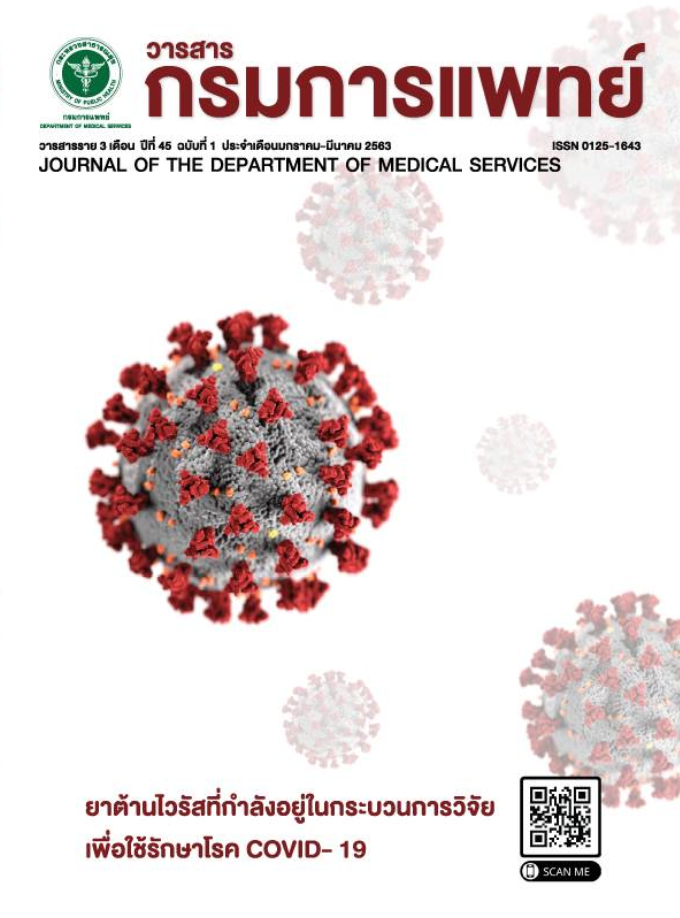The Level of Memory B Cells (CD27+ CD19+) in Patient with Neuromyelitis Optica Spectrum Disorder with Positive AQP4-IgG Antibody
Keywords:
Neuromyelitis Optica Spectrum Disorder (NMOSD), Memory B cells, Flow cytometryAbstract
Neuromyelitis Optica Spectrum Disorder (NMOSD) is a central nervous system inflammatory disorder. One part of pathogenesis of disease is related to abnormal B cells function and cytokine expression especially B cells sub population called memory B cells (CD27 + CD19 +). The objective of this study is to compare the percentage of memory B cells between patients diagnoses with NMOSD and healthy subject control. The secondary objective is to compare percentage of memory B cells between the private laboratory and the laboratory of Institute of Pathology, Department of Medical Services. The blood from ten patients with NMOSD and equal number of healthy subject control were analyzed as percentage of memory B cell (CD27+ CD19+) by using flow cytometry. The percentage of memory cells were compared between patients with NMOSD and healthy subject control. Moreover the result of memory B cell from commercial private laboratory was compared with laboratory form Institute of Pathology, Department of Medical Services. The result shown percentage of memory B cells (CD27+ CD19+) in patients with NMOSD was significance higher than healthy subject control. The percentage difference of memory cell was 2.54% (p=0.028). In patients with recent relapse, the percentage of memory B cells was significance higher than non-relapse groups which 5.71% higher (p=0.003). There was no significance difference percentage of memory cells across private laboratory and laboratory of Institute of pathology, Department of medical service (p=0.064).
References
Lennon VA, Wingerchuk DM, Kryzer TJ, Pittock SJ, Lucchinetti CF, Fujihara K, et al. A serum autoantibody marker of neuromyelitis optica: distinction from multiple sclerosis. Lancet 2004;364:2106-12.
Wingerchuk DM, Lennon VA, Lucchinetti CF, Pittock SJ, Weinshenker BG. The spectrum of neuromyelitis optica. Lancet Neurol 2007;6:805-15.
Krumbholz M, Meinl E. B cells in MS and NMO: pathogenesis and therapy. Semin Immunopathol 2014;36:339-50.
Bedi GS, Brown AD, Delgado SR, Usmani N, Lam BL, Sheremata WA. Impact of rituximab on relapse rate and disability in neuromyelitis optica. Mult Scler 2011;17:1225-30.
Collongues N, Brassat D, Maillart E, Labauge P, Ouallet JC, Carra-Dalliere C, et al. Efficacy of rituximab in refractory neuromyelitis optica. Mult Scler 2016;22:955-9.
Damato V, Evoli A, Iorio R. Efficacy and Safety of Rituximab Therapy in Neuromyelitis Optica Spectrum Disorders: A Systematic Review and Meta-analysis. JAMA Neurol 2016;73:1342-8.
Han J, Sun L, Wang Z, Fan X, Wang L, Song YY, et al. Circulating regulatory B cell subsets in patients with neuromyelitis optica spectrum disorders. Neurol Sci 2017;38:1205-12.
Lebrun C, Cohen M, Rosenthal-Allieri MA, Bresch S, Benzaken S, Marignier R, et al. Only Follow-Up of Memory B Cells Helps Monitor Rituximab Administration to Patients with Neuromyelitis Optica Spectrum Disorders. Neurol Ther 2018; 7: 373-83.
Kim SH, Kim W, Li XF, Jung IJ, Kim HJ. Repeated treatment with rituximab based on the assessment of peripheral circulating memory B cells in patients with relapsing neuromyelitis optica over 2 years. Archives Neurol 2011;68:1412-20.
Downloads
Published
How to Cite
Issue
Section
License
บทความที่ได้รับการตีพิมพ์เป็นลิขสิทธิ์ของกรมการแพทย์ กระทรวงสาธารณสุข
ข้อความและข้อคิดเห็นต่างๆ เป็นของผู้เขียนบทความ ไม่ใช่ความเห็นของกองบรรณาธิการหรือของวารสารกรมการแพทย์



